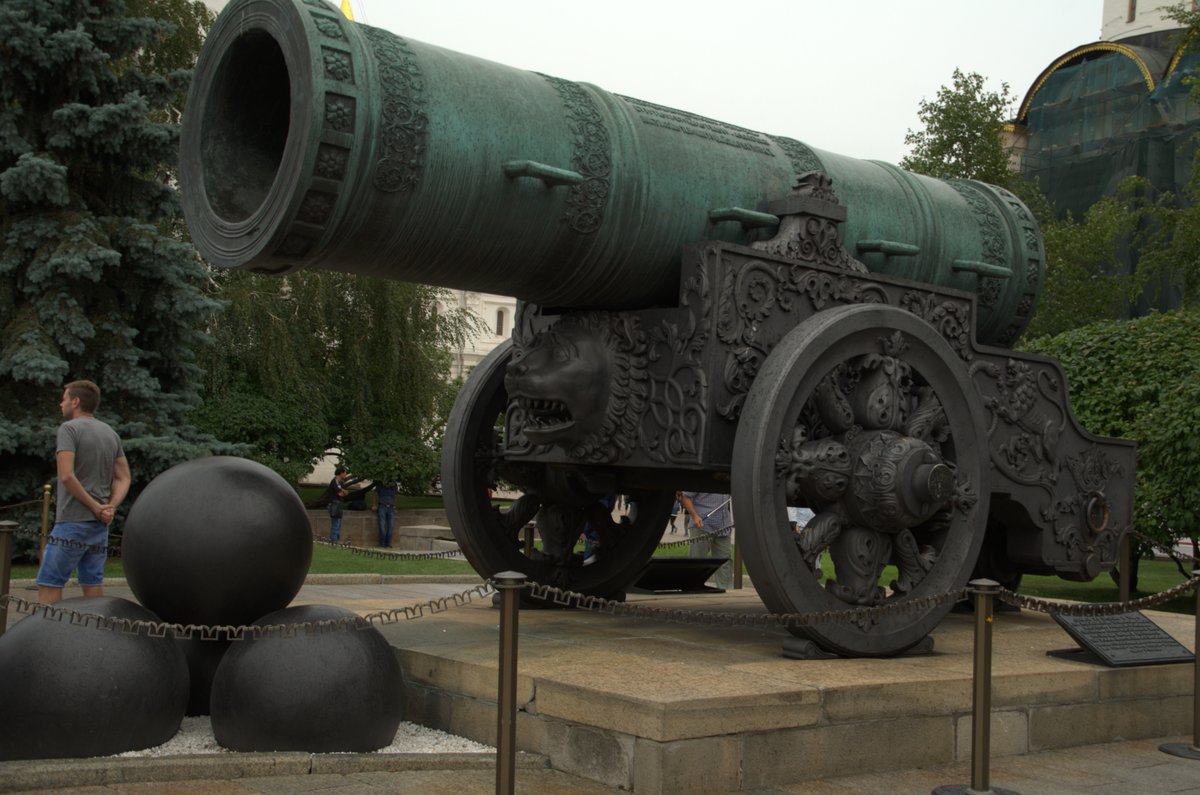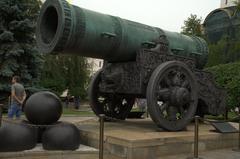
Tsar Cannon Visiting Hours, Tickets, and Guide to Moscow Historical Sites
Date: 14/06/2025
Introduction: Moscow’s Monument to Power and Craftsmanship
The Tsar Cannon, proudly displayed within the Moscow Kremlin, is one of Russia’s most celebrated historical monuments. Cast in 1586 by the master Andrey Chokhov on the orders of Tsar Feodor Ioannovich, this gigantic bronze artillery piece is a testament to the technical prowess, artistry, and ambitions of Muscovy at the dawn of the modern era. While never used in battle, its colossal dimensions and ornate decorations have made it a symbol of Russian military might and royal authority. Located on Ivanovskaya Square, near the renowned Tsar Bell and Ivan the Great Bell Tower, the Tsar Cannon is an essential stop for anyone interested in Russian history, architecture, or culture.
This guide explores the Tsar Cannon’s origins, technical and artistic features, its symbolic significance, and provides all the practical information needed for a memorable visit. For up-to-date details, always consult the Moscow Kremlin Official Website and related tourism resources. (Kremlin Museum, Wikipedia, ermakvagus.com)
Table of Contents
- Introduction
- History and Commissioning
- Technical and Artistic Features
- Symbolic Role and Function
- Placement and Historical Movements
- Restoration and Preservation
- Visiting Hours, Tickets, and Accessibility
- Nearby Attractions and Travel Tips
- FAQs
- Summary and Visitor Recommendations
- Sources
History and Commissioning
Commissioned by Tsar Feodor Ioannovich in 1586, the Tsar Cannon was created by the renowned bronze caster Andrey Chokhov at the Moscow Cannon Court. At this time, Moscow faced military threats, particularly from Crimean-Tatar forces. The cannon was envisioned as both a functional defensive weapon and a display of the Tsardom’s technological sophistication. Though originally intended to fire stone grapeshot to protect the Kremlin’s approaches, the cannon quickly became a ceremonial symbol rather than an instrument of war. (Advantour)
Technical and Artistic Features
Dimensions and Construction
- Length: 5.34 meters (17.5 feet)
- Caliber (internal diameter): 890 mm (35 inches)
- Weight: Approximately 39.3–40 metric tons
- Material: High-quality bronze
- Carriage and Cannonballs: Added in 1835; the decorative cast-iron carriage and four iron cannonballs are for display only. Each cannonball weighs nearly two tons.
Ornamentation
- Barrel Relief: Features an equestrian portrait of Tsar Feodor Ioannovich, symbolizing royal power.
- Decorative Bands: Richly adorned with floral and geometric motifs.
- Inscriptions: In Cyrillic, noting the date of casting (7094 in the Byzantine calendar, 1586 Gregorian) and crediting Chokhov.
The technical aspects of the cannon, particularly its immense caliber, have earned it a Guinness World Record. Its elaborate surface decoration and monumental scale make it a unique fusion of military engineering and decorative art. (Military History Fandom, brilliant-tourism.com)
Symbolic Role and Function
Despite its intimidating size and strategic placement, the Tsar Cannon was never fired in battle. Historical analysis indicates its relatively thin barrel walls and fixed mounting suggest it was not designed for combat use. Instead, it served as a ceremonial object—a grand statement of the Tsar’s authority and the Moscow state’s power. The four decorative cannonballs, cast centuries later, reinforce its symbolic rather than practical function. (Moscow Info)
Placement and Historical Movements
Originally situated near Red Square’s Place of Skulls to defend the Kremlin’s eastern approaches, the Tsar Cannon has been relocated several times. After the 1706 move to the Kremlin Arsenal, it narrowly escaped being taken by Napoleon in 1812, though its original carriage was destroyed in the fire. In 1835, a new decorative cast-iron carriage and cannonballs were added, and the cannon was moved to Ivanovskaya Square, where it remains today. (Kremlin Museum)
Restoration and Preservation
The Tsar Cannon has been carefully preserved through several restoration campaigns. Studies in the late 20th century found traces of gunpowder, indicating it was likely test-fired at least once. Modern conservation efforts have focused on maintaining both its structural integrity and decorative features, ensuring its continued role as a Moscow landmark. (Military History Fandom, ermakvagus.com)
Visiting Hours, Tickets, and Accessibility
Location
- Site: Ivanovskaya Square, Moscow Kremlin
Getting There
- Nearest Metro Stations: Biblioteka Imeni Lenina, Aleksandrovsky Sad, Borovitskaya
Hours
- Open: Tuesday–Sunday, 10:00 AM–6:00 PM (last admission at 4:30 or 5:00 PM)
- Closed: Mondays and certain holidays. Always check the Kremlin website for updates.
Tickets
- Price: As of June 2025, general Kremlin grounds entry is approximately 500 RUB; includes access to the Tsar Cannon area.
- How to Buy: Online purchase is strongly recommended (Russiable). Buy tickets at the Kremlin’s Alexander Garden booths or online and exchange your voucher at booths 6, 7, or 8.
Accessibility
- The Kremlin grounds are mostly accessible, with paved walkways to the Tsar Cannon. Some cobblestone areas may require caution for visitors with limited mobility.
Photography
- Permitted from all sides, but touching or climbing on the cannon or cannonballs is prohibited. Tripods and drones are not allowed.
Facilities
- Restrooms and food outlets are available elsewhere in the Kremlin; they are not immediately adjacent to the Tsar Cannon.
Nearby Attractions and Travel Tips
- Tsar Bell: Another colossal artifact nearby.
- Cathedral Square: Surrounded by the Assumption Cathedral, Archangel Cathedral, and the Ivan the Great Bell Tower.
- Armoury Chamber: Requires a separate ticket; houses royal regalia and treasures.
- Red Square and St. Basil’s Cathedral: Just outside the Kremlin walls.
Tips:
- Arrive early for smaller crowds and better photo opportunities.
- Dress for the weather, especially in winter.
- Plan at least two hours for the Kremlin outdoor sites.
- Consider a guided tour for in-depth historical context.
(World of Wanderlust, National Traveller)
FAQs
Q: What are the Tsar Cannon visiting hours?
A: Tuesday–Sunday, 10:00 AM–6:00 PM; closed on Mondays. Details may vary seasonally.
Q: How can I buy tickets?
A: Online in advance is best, or at the Kremlin’s ticket booths.
Q: Is the Tsar Cannon accessible for disabled visitors?
A: Yes, the area is generally accessible, though some uneven surfaces exist.
Q: Are guided tours available?
A: Yes, many tours in various languages include the Tsar Cannon.
Q: Can I take photos?
A: Yes, photography is allowed, but do not use tripods or drones, and do not touch the monument.
Summary and Visitor Recommendations
The Tsar Cannon is more than just a massive piece of artillery—it is a symbol of Russia’s imperial ambitions, technical skill, and artistic achievement. Its intricate reliefs, monumental scale, and strategic placement within the Kremlin have made it a favorite for visitors seeking to connect with Moscow’s storied past. Plan ahead by purchasing tickets online, arriving early, and considering a guided tour for the richest experience. Don’t miss nearby attractions to complete your journey through Russian history.
For official updates, ticketing, and additional travel resources, always consult the Moscow Kremlin Official Website.
Sources and Further Reading
- Kremlin Museum
- Wikipedia
- Advantour
- Military History Fandom
- ermakvagus.com
- brilliant-tourism.com
- Moscow Info
- World of Wanderlust
- Russiable
- RBTH
- Amusing Planet
- National Traveller





















































































































































































































































































